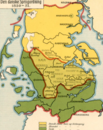Denmark did not originally belong to the distribution area of Low German. The language border between the South Jutian dialect of Danish and Low German formerly ran along the cities of Husum and Schleswig and thus approximately 30 kilometers south of the modern country border. However, Danish was displaced from large parts of Schleswig in the 19th century and the inhabitants adopted Low German in its Schleswiger form.
North Schleswig, which is now part of Denmark, was part of the German Empire from 1867 to 1920, and before that it was part of Denmark together with South Schleswig. German minorities had formed in cities such as Tondern, Apenrade and Hadersleben. There were few Germans in the villages. Some of the German minority stayed in Denmark even after 1920. In addition to Danish, they spoke and still speak Low German on the one hand and Standard German on the other.
The size of the German minority in the south of Denmark is said to be around 15,000 to 20,000 people, of whom only some speak Low German. The region does not have its own dialect. The Low German spoken there completely corresponds with the Schleswig Low German, which is spoken south of the state border too. The dialect only has own expressions for a few things that are unique to Denmark.

